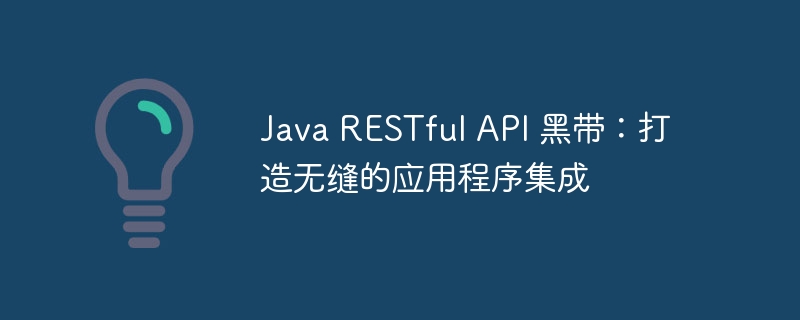Java RESTful API Black Belt: Creating Seamless Application Integration

Java RESTful API Black Belt: Creating Seamless Application Integration RESTful API is one of the indispensable technologies in modern application development, providing a seamless way to integrate different applications. In this article, PHP editor Strawberry will lead you to an in-depth discussion on how to use Java technology to create an efficient and stable RESTful API, so that your application can have stronger integration performance and achieve more flexible application development.
- Resource-centered approach: API should be designed around business resources (e.g. customers, orders). Each resource should have a unique URI that is used to perform CRUD (Create, Read, Update, Delete) operations on that resource.
- Stateless: API interactions should not depend on server state. Each request should contain all necessary information and should not be affected by previous requests.
- Unified interface: APIs should use a standard set of Http methods (GET, POST, PUT, DELETE) and media types (JSON, XML). This simplifies application interaction with the API.
Implementation Technology The Java community provides a wide range of libraries and frameworks to help implement RESTful APIs, including:
- Jakarta EE: An enterprise Java platform specification that provides the JAX-RS API for building RESTful APIs.
- Spring Framework: A popular JAVA WEB framework with strong support for RESTful API development.
- Dropwizard: A lightweight framework designed for rapid development of high-performance RESTful APIs.
Best Practices To ensure your RESTful API is efficient and reliable, follow these best practices:
- Use appropriate HTTP status codes: Indicate status such as operation success (200 OK), creation of a new resource (201 Created), or server error (500 Internal Server Error).
- Using HATEOAS (Hypermedia as Application State Engine): Provides links to related resources in responses, allowing applications to easily navigate the API.
- Handling exceptions: Handle errors gracefully and provide meaningful error messages to the caller.
- Performance optimization: Use caching, compression, and distributedarchitecture to improve API performance.
- Security Considerations: Implement authentication, authorization, and encryption measures to protect the API from unauthorized access.
Testing and Troubleshooting Thorough testing of RESTful APIs is critical to ensure their correctness and reliability. Validate all aspects of the API using unit tests, integration tests, and Performance tests.
Troubleshooting is a critical part of the API development process. Use LoggingLogging, Debugging, and Performance AnalysisTools to identify and resolve issues in the API.
Continuous Integration and Delivery To maintain consistency and quality of your API during development and maintenance, follow continuous integration and delivery (CI/CD) practices. Streamline the API development lifecycle using version control, automated testing, and deployment pipelines.
in conclusion Mastering the design, implementation, and maintenance of Java RESTful APIs are essential skills for modern Java developers. By following best practices, leveraging powerful libraries and tools, and implementing CI/CD practices, you can create seamless application integrations and provide an unparalleled experience to your users.
The above is the detailed content of Java RESTful API Black Belt: Creating Seamless Application Integration. For more information, please follow other related articles on the PHP Chinese website!

Hot AI Tools

Undresser.AI Undress
AI-powered app for creating realistic nude photos

AI Clothes Remover
Online AI tool for removing clothes from photos.

Undress AI Tool
Undress images for free

Clothoff.io
AI clothes remover

AI Hentai Generator
Generate AI Hentai for free.

Hot Article

Hot Tools

Notepad++7.3.1
Easy-to-use and free code editor

SublimeText3 Chinese version
Chinese version, very easy to use

Zend Studio 13.0.1
Powerful PHP integrated development environment

Dreamweaver CS6
Visual web development tools

SublimeText3 Mac version
God-level code editing software (SublimeText3)

Hot Topics
 1378
1378
 52
52
 How does Java's classloading mechanism work, including different classloaders and their delegation models?
Mar 17, 2025 pm 05:35 PM
How does Java's classloading mechanism work, including different classloaders and their delegation models?
Mar 17, 2025 pm 05:35 PM
Java's classloading involves loading, linking, and initializing classes using a hierarchical system with Bootstrap, Extension, and Application classloaders. The parent delegation model ensures core classes are loaded first, affecting custom class loa
 How do I implement multi-level caching in Java applications using libraries like Caffeine or Guava Cache?
Mar 17, 2025 pm 05:44 PM
How do I implement multi-level caching in Java applications using libraries like Caffeine or Guava Cache?
Mar 17, 2025 pm 05:44 PM
The article discusses implementing multi-level caching in Java using Caffeine and Guava Cache to enhance application performance. It covers setup, integration, and performance benefits, along with configuration and eviction policy management best pra
 How can I use JPA (Java Persistence API) for object-relational mapping with advanced features like caching and lazy loading?
Mar 17, 2025 pm 05:43 PM
How can I use JPA (Java Persistence API) for object-relational mapping with advanced features like caching and lazy loading?
Mar 17, 2025 pm 05:43 PM
The article discusses using JPA for object-relational mapping with advanced features like caching and lazy loading. It covers setup, entity mapping, and best practices for optimizing performance while highlighting potential pitfalls.[159 characters]
 How do I use Maven or Gradle for advanced Java project management, build automation, and dependency resolution?
Mar 17, 2025 pm 05:46 PM
How do I use Maven or Gradle for advanced Java project management, build automation, and dependency resolution?
Mar 17, 2025 pm 05:46 PM
The article discusses using Maven and Gradle for Java project management, build automation, and dependency resolution, comparing their approaches and optimization strategies.
 How do I create and use custom Java libraries (JAR files) with proper versioning and dependency management?
Mar 17, 2025 pm 05:45 PM
How do I create and use custom Java libraries (JAR files) with proper versioning and dependency management?
Mar 17, 2025 pm 05:45 PM
The article discusses creating and using custom Java libraries (JAR files) with proper versioning and dependency management, using tools like Maven and Gradle.




